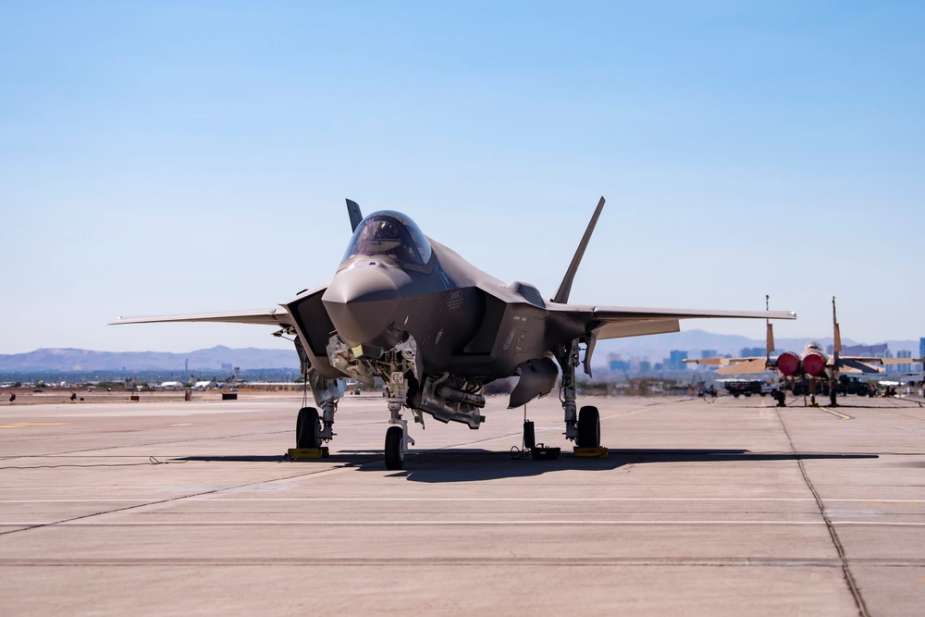US F-35A becomes first fifth-generation stealth fighter certified to carry thermonuclear bombs
On March 8, 2024, Breaking Defense reported that the F-35A stealth fighter had been officially certified to carry the B61-12 thermonuclear gravity bomb, as announced by a spokesperson from the F-35 Joint Program Office (JPO). This certification, completed on October 12, 2023, marks the first time that a fifth-generation stealth fighter has been certified with a nuclear weapon. Achieved ahead of the initially scheduled January 2024, this development had been communicated to NATO allies prior to the public announcement.
Follow Army Recognition on Google News at this link

An F-35A Lightning II carrying a B61-12 Joint Test Assembly during the inaugural Full Weapon System Demonstration in September 2021. (Picture source: US DoD)
This certification establishes the F-35A as the first fifth-generation fighter with a "dual-capable" designation, meaning it can carry both conventional and nuclear weapons. It becomes the second US fighter aircraft, following the F-15E, to be authorized to carry the B61-12 thermonuclear bomb. The completion of this certification is the culmination of an extensive collaboration that spanned over a decade, involving 16 government and industry stakeholders, as per the information provided by JPO spokesperson Russ Goemaere.
The newly certified capability is contextualized within the framework of enhancing the US Air Force's operational range, particularly in delivering tactical nuclear gravity bombs in areas where there is a potential for engagement by adversary defenses. This capability, integrated into the stealth characteristics of the F-35A, is seen as a strategic addition amid current global tensions, such as the conflict in Ukraine, and is aimed at strengthening the defense capabilities of NATO countries, especially those participating in the nuclear-sharing arrangement and planning to integrate F-35As into their air forces.
Approximately 100 B61 tactical nuclear bombs have been stationed across various allied European countries, including Belgium, Germany, Italy, the Netherlands, and Türkiye. The detailed schedule for replacing older aircraft with F-35As equipped with B61-12 bombs in these nations remains unspecified, although there have been mentions of an initiation in late 2022. According to the US Air Force Air Combat Command, all F-35As in service are expected to be upgraded to support this nuclear functionality, although specific operational details were not disclosed.
The nuclear certification is specific to the F-35A variant, indicating its role in replacing the older F-16 fighters concerning tactical nuclear capabilities. This distinction sets it apart from other variants such as the F-35B and F-35C and from the F-22 Raptor stealth fighter, which is primarily focused on air-to-air combat. To support the B61-12, the F-35A required certain modifications, including the installation of specific wiring and data links, part of the Block 4 upgrades. However, not all Block 4 enhancements are needed for the nuclear role.
The US Air Force has noted that this nuclear certification is limited to the B61-12 variant, and does not extend to older models like the B61-3 or B61-4. The B61-12 is part of a broader nuclear modernization initiative, which also anticipates the development of newer versions such as the B61-13, as announced by the Biden administration.
Introduced as the latest model in the B61 series, which has been operational since 1968, the B61-12 features design modifications for both strategic and tactical applications, adopting a two-stage radiation implosion design that allows variable yield settings. The bomb is undergoing a Life Extension Program (LEP), aimed at refurbishing and replacing aged components to extend its service life by 20 years, enhancing safety and reliability. This program, involving a modification of 400 bombs, has an allocated budget of $7.6 billion and is expected to be completed by 2025.
The B61-12, measuring 6.4 meters in length and weighing approximately 374 kg, is designed for various deployment methods, incorporating a new tail kit guidance assembly for improved guidance and accuracy, an inertial navigation system (INS) to enhance strike precision, and four warhead options (0.3kt, 1.5kt, 10kt, and 50kt) to adjust detonation strength, improving the survivability of the launch platform.
- Hits: 2478
















